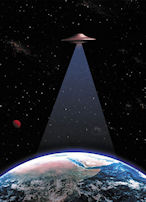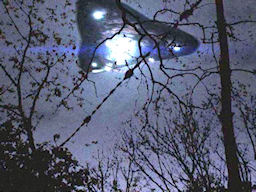How Do UFOs Get Here?
Getting to the Moon and back is an expensive and trying business, which only a few of the great nations of the Earth could undertake, even now. Getting all the way out to Mars presents a feat of endurance and technical mastery that remains beyond all but an extremely well-funded NASA. These worlds are our cosmic neighbours. They are in our backyard, a space that is inconsequential compared to the vast distances between the stars.
Let us assume that Einstein was right. However we may wish to, we simply cannot travel faster than the speed of light.
We may theoretically consider warp speed, or hyper-drives, or teleportation. But, in practice, we are stuck with moving physical matter through the immense vacuum of space.
Aliens who wish to visit our adorable blue world from across the Cosmos must overcome an enormous hurdle. Even at speeds close to that of light, which incurs its own remarkable set of problems, efforts to overcome this hurdle involve many years of travelling. And that's just from the nearest stars.
Many sceptics who argue against a UFO reality present this simple argument as a sure-fire reason to dismiss the concept of alien visitation. It simply takes too long for them to get here.
 The
nuclear physicist and Ufologist Stanton
Friedman argues that our culture
underestimates the potential for
nuclear-powered spacecraft. Nuclear
fusion or fission reactors would be
capable of ejecting high speed particles
from a spaceship's propulsion system,
generating acceleration. In the vacuum
of space, this increase in speed would
be ongoing for the lifetime of the
nuclear reactor, generating incredible
speeds in a relatively short time-span.
But one is still left with journey times
of many years, not weeks or months.
The
nuclear physicist and Ufologist Stanton
Friedman argues that our culture
underestimates the potential for
nuclear-powered spacecraft. Nuclear
fusion or fission reactors would be
capable of ejecting high speed particles
from a spaceship's propulsion system,
generating acceleration. In the vacuum
of space, this increase in speed would
be ongoing for the lifetime of the
nuclear reactor, generating incredible
speeds in a relatively short time-span.
But one is still left with journey times
of many years, not weeks or months.
Many
Ufologists, like author Timothy Good,
provide evidence that UFOs are based
here, even if they once originated from
elsewhere. In other words, there are
alien bases on Earth from whence the
intrusive and elusive UFOs emerge to
skit about in our skies.
Perhaps such bases exist on neighbouring
planets, like Mars. Perhaps great 'motherships'
visit our world from distant stars,
slowly traversing the Cosmos to drop off
flying saucers into our atmosphere.
The science writer Carl Sagan advocated
interstellar travel in cored-out comets.
These great balls of rock and ice orbit
the Sun in distant, elongated orbits.
But some of their cousins also travel
through the galaxy between the stars. If
a space-faring civilisation were to
hitch a ride, these comets would provide
a small world to live within across the
cold of deep space. A succession of
generations could wait out their time
before arrival at the star system they
hope to colonise.
So, have aliens colonised our star system then? Well, if they were looking for a sensible place to settle in the solar system, Earth appears to be the only viable habitat in town. The need to inhabit a world in what astronomers call 'The Goldilocks Zone' brings us to a list with a sole candidate: the Earth. So, maybe Tim Good is right to argue that they are here, among us.
Or, perhaps there is also another possibility. Not all stars are bright. Some failed stars no longer shine with the light of their birth, but lie hidden in the skies; invisible needles in the cosmic haystack. These dark, stellar worlds, known to astronomers as brown dwarfs, could be found anywhere. Some are like planets, orbiting parent stars, and others independently traverse the spaces between the stars.
If the Sun was close to one of these failed stars, we may not realise it yet. This seems a stunning claim, but it is a reasonable contention. These small failed stars, known as sub-brown dwarfs, are very difficult to detect. Yet they would be sufficiently massive to offer a warm environment for life on their own families of planets. In a stroke, such a scenario would overcome the concern about the huge distances between the stars. Another habitable zone would be viable within striking distance of the known planets.
Of course, with the Moon still offering us a significant space-faring challenge, it will be a while before our species is able to travel to such a dark star, even if one were to be found nearby. But that does not mean that we haven't been visited from there...
Article by Andy Lloyd, 15th October 2008
 This
connection was all the more worrying when the sensitive sites
were nuclear. There is a secret history of UFO intrusion upon
sensitive nuclear sites, particularly nuclear missile launch
facilities. It’s a scary subject, because nuclear deterrent is
a gun whose trigger is light. The systems operating a nation’s
nuclear deterrent may be complex, but they are designed to be
reactive in an extremely short time period.
This
connection was all the more worrying when the sensitive sites
were nuclear. There is a secret history of UFO intrusion upon
sensitive nuclear sites, particularly nuclear missile launch
facilities. It’s a scary subject, because nuclear deterrent is
a gun whose trigger is light. The systems operating a nation’s
nuclear deterrent may be complex, but they are designed to be
reactive in an extremely short time period.  The
purpose of these unwelcome visits is not entirely clear. But
consider this: the advent of the UFO phenomenon really got
going in the years following the dropping of the first atom
bombs. The Roswell incident occurred in the vicinity of the
world’s only nuclear bomber squadron at that time. The
Rendlesham Forest incident in the UK occurred in the vicinity of
a nuclear weapons storage area at nearby RAF Bentwaters.
Encounters with UFOs over nuclear missile launch facilities have
sometimes been associated with technical problems at those
sites, like those experienced at Malmstrom AFB in 1967.
The
purpose of these unwelcome visits is not entirely clear. But
consider this: the advent of the UFO phenomenon really got
going in the years following the dropping of the first atom
bombs. The Roswell incident occurred in the vicinity of the
world’s only nuclear bomber squadron at that time. The
Rendlesham Forest incident in the UK occurred in the vicinity of
a nuclear weapons storage area at nearby RAF Bentwaters.
Encounters with UFOs over nuclear missile launch facilities have
sometimes been associated with technical problems at those
sites, like those experienced at Malmstrom AFB in 1967. 